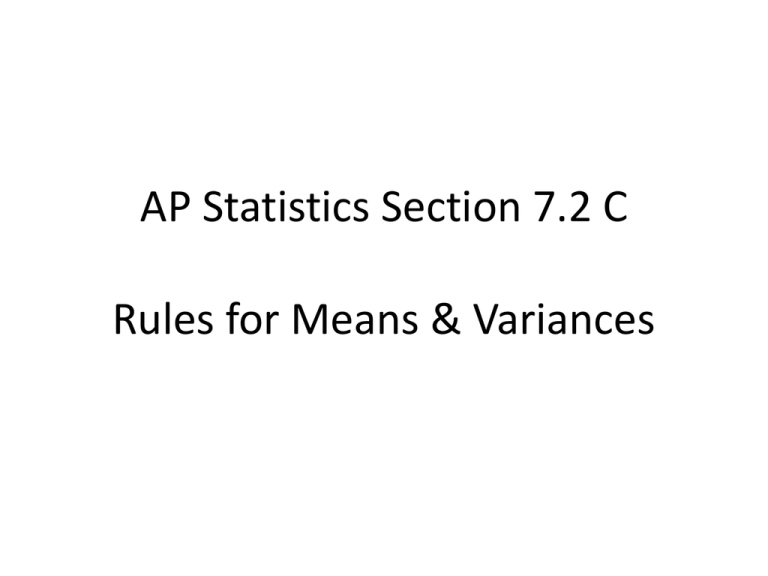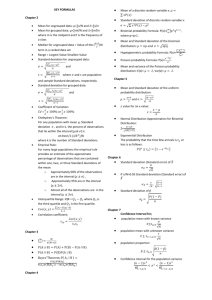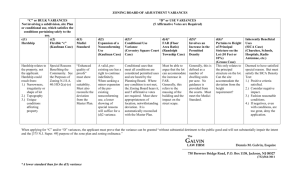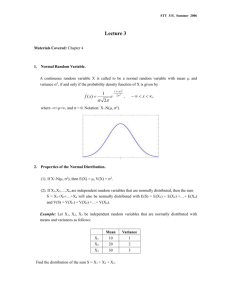AP Statistics Section 7.2 C Rules for Means & Variances
advertisement

AP Statistics Section 7.2 C Rules for Means & Variances Consider the independent random variables X and Y and their probability distributions below: 2 .7 2 . 41 2 .6 . 84 x 1(. 2 ) 2 (. 5 ) 5 (. 3 ) 2 . 7 x (1 2 . 7 ) (. 2 ) ( 2 2 . 7 ) (. 5 ) ( 5 2 . 7 ) (. 3 ) 2 . 41 2 2 2 2 Build a new random variable X + Y and calculate the probabilities for the values of X + Y. 3 5 4 6 7 9 3 .14 4 .35 5 .06 6 .15 7 .21 P(3) P(1 2) .2 .7 .14 9 .09 Use your calculator to calculate the mean of the random variable X + Y. x y 5 .3 Note that the mean of the sum x y = ____ 5 . 3 equals the sum of the means x y =______________ 2 .7 2 .6 5 .3 : Use your calculator to calculate the variance of the random variable X + Y. 2 x y 3 . 25 Note that the variance of the sum equals the sum of the variances: 2 x 2 y 2 . 41 . 84 3 . 25 Repeat the steps above for the random variable X – Y. 1 -3 0 -2 3 1 3 2 1 0 1 3 .06 .15 .14 .35 .09 .21 Verify x y x y . . 1 2.7 2.6 .1 .1 Repeat the steps above for the random variable X – Y. 3 2 1 0 1 3 .06 .15 .14 .35 .09 .21 1 -3 0 -2 3 1 Calculate the variance of the random variable X – Y. x y 3 . 25 2 Note that the variance of the difference the sum of the variances 2 x x y 2 and equals 2 y Rules for Means Rule 1: If X is a random variable and a and b are a b . constants, then _______ a bx If a is added to each value If each value x of x, then a is added to the mean as well. of x is multiplied multiplied by b , then the mean is by b as well. Rules for Means Rule 2: If X and Y are random variables, then ______and _______ x y x y x y x y Rules for Variances Rule 1: If X is a random variable and a and b are 2 2 2 b constants, then a bx ______ x Adding a to each value Multiplyin g each value of x does not change the variance. of x by b , multiplies the variance by b 2 Rules for Variances Rule 2: If X and Y are independent random variables, then x y x 2 2 2 y and x - y 2 2 x 2 y Example: Consider two scales in a chemistry lab. Both scales give answers that vary a little in repeated weighings of the same item. For a 2 gram item, the first scale gives readings X with a mean of 2g and a standard deviation of .002g. The second scale’s readings Y have a mean of 2.001g and a standard deviation of .001g. If X and Y are independent, find the mean and standard deviation of Y – X. y x y x 2 . 001 2 . 001 g 2 yx yx 2 y 2 x . 002 2 . 001 . 000005 2 . 000005 . 002236 Example: Consider two scales in a chemistry lab. Both scales give answers that vary a little in repeated weighings of the same item. For a 2 gram item, the first scale gives readings X with a mean of 2g and a standard deviation of .002g. The second scale’s readings Y have a mean of 2.001g and a standard deviation of .001g. You measure once with each scale and average the readings. Your result is Z = (X+Y)/2. Find . Note : z 1 x 1 y 2 2 z 1 x 1 y . 5 ( 2 ) . 5 ( 2 . 001 ) 2 . 0005 2 2 z z 2 2 1 x 1 y 2 2 1 2 . 00000125 2 x 1 2 2 y 2 1 2 2 (. 001 ) (. 002 ) 1 . 001118034 2 2 2 . 00000125 Any linear combination of independent Normal random variables is also Normally distributed. Example: Tom and George are playing in the club golf tournament. Their scores vary as they play the course repeatedly. Tom’s score X has the N(110, 10) distribution and George’s score Y has the N(100, 8) distribution. If they play independently, what is the probability that Tom will score lower than George? Table : P ( X Y ) P ( X Y 0) 0 - 10 z . 78 12.806 . 2177 10 0 12 . 806 Calculator : x y 110 100 10 normalcdf( -10000,0,1 0,12.806) x y .2174 10 8 12 . 806 2 2











